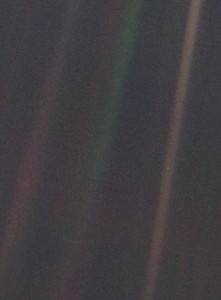ELSI Blog
7 Life on a Pale Blue Dot
Carl Sagan's name was a household word, in the early eighties, in the U.S. as well as elsewhere. With his television program "Cosmos: A Personal Voyage", he awakened hundreds of millions of people to the joy of astronomy, and the joy of science in general. I myself had the joy of meeting him a few times in the mid eighties, when I started to work on mass extinctions, including the demise of the dinosaurs, a topic that drew his keen interest. During some lively dinner conversations we talked about ways to deflect asteroids in attempts to prevent future mass extinctions from happening, which would inspire me years later to co-found the B612 foundation with astronauts Ed Lu and Rusty Schweickart and fellow astronomer Clark Chapman.
One expression Carl is being remembered for is to describe the Earth as the `pale blue dot', a one-pixel spot in a photograph taken by the Voyager 1 spacecraft from a distance of four billion miles. He wrote in his book by the same name:
From this distant vantage point, the Earth might not seem of any particular interest. But for us, it's different. Consider again that dot. That's here. That's home. That's us. On it everyone you love, everyone you know, everyone you ever heard of, every human being who ever was, lived out their lives. The aggregate of our joy and suffering, thousands of confident religions, ideologies, and economic doctrines, every hunter and forager, every hero and coward, every creator and destroyer of civilization, every king and peasant, every young couple in love, every mother and father, hopeful child, inventor and explorer, every teacher of morals, every corrupt politician, every "superstar," every "supreme leader," every saint and sinner in the history of our species lived there -- on a mote of dust suspended in a sunbeam.
The Earth is a very small stage in a vast cosmic arena. Think of the rivers of blood spilled by all those generals and emperors so that in glory and triumph they could become the momentary masters of a fraction of a dot. Think of the endless cruelties visited by the inhabitants of one corner of this pixel on the scarcely distinguishable inhabitants of some other corner.
What a power of vision, and what a power of expression, to find a three-word `sound bite', together with a few sentences to characterize human history and human joy and folly.
This coming Friday, there will be a follow up staged by the Cassini spacecraft.
In the words of Carolyn Porco, the leader of the imaging science team of Cassini:

The Voyager 1 photograph of the Earth, to the right of the center : NASA
On July 19, 2013, the Cassini spacecraft, currently in orbit around Saturn, will be turned to image that planet and its entire ring system during an eclipse of the sun, as it has done twice before during its previous 9 years in orbit. But this time will be very different. This time, the images collected will capture, in natural color, a glimpse of our own planet alongside Saturn and its rings on a day that will be the first time the Earth's inhabitants know in advance their picture is being taken from a billion miles away. It will be a day to revel in the extraordinary achievements in the exploration of our solar system that have made such an interplanetary photo session possible. And it will be a day for all of us to smile and celebrate life on the Pale Blue Dot.
July 19, 2013 has been designated as "The Day the Earth Smiled". In our next blog entry, on July 19, Yuka Fujii, an astronomer specializing in "one-pixel observations" and a member of ELSI, will tell us more about this memorable day, and about her own research.











